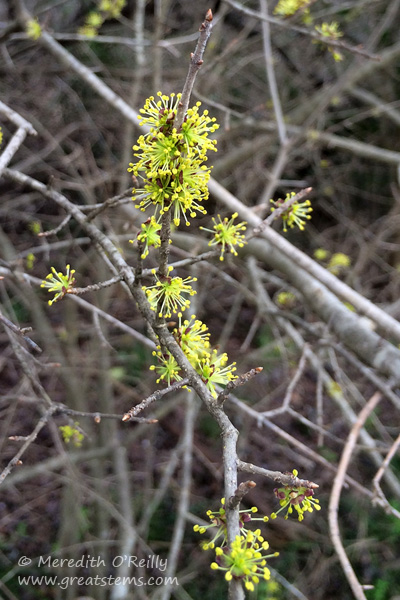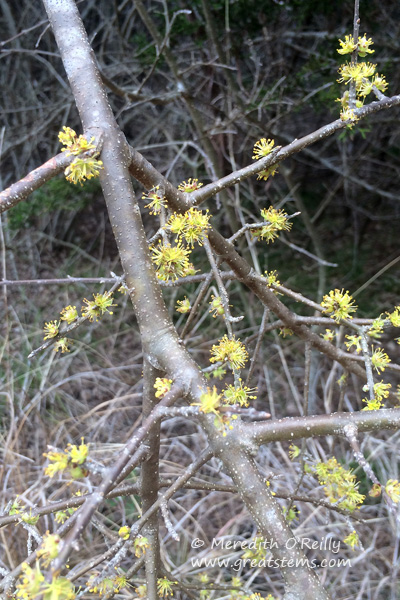This morning my dogs and I visited our favorite leash-free nature-plenty park for a bit of exercise. We enjoyed following the paths through a winter assortment of evergreens, bare-branched deciduous woody plants, and golden-to-brown spent grasses and herbaceous plants (granted, the dogs were far more interested in animal smells while I, on the other hand, forego those risky smells and instead admired the plants). But I pulled up short when I spotted this treasure among the winter scene, tiny yellow-green blooms looking like miniature fireworks among the brown branches. I knew immediately that Elbow Bush was announcing the imminent arrival of spring ahead.

Elbow Bush, or Forestiera pubescens, is a deciduous Southwestern shrub that blooms much earlier in the year (Feb-Mar) than most other plants in the region. In fact, another of its nicknames is Spring Herald. Its blooms, which open before new leaves bud out, are important nectar sources for early-emerging butterflies and other pollinators. Later on, the female plants will produce dark-blue berries that are a favorite of wildlife.

Yet another name for Forestiera pubescens is Stretchberry. But here in our area, I know this shrub best as Elbow Bush, a name earned because the plant typically branches at right angles. It has tremendous wildlife value and makes a great understory addition, but gardeners should note that it does have a thicket-forming habit. So perhaps it might serve a naturalistic landscape best.
It won’t be long, and this plant like so many others will be covered in green foliage. Also spotted in bloom today — Mexican Plum, Agarita, and one wee little bloom on a Mountain Laurel (and all three were deliciously fragrant, too — I couldn’t help but check). Spring cometh!
You reminded me of how much I loved elbow bush when I lived with it in the hill country. It also provides nectar to early butterflies and is the host plant for the hairstreak. Definitely one to add to Hill Country – and westward – yards.
It is indeed a valuable wildlife plant, Marilyn — I really want to establish a thicket with it in my yard.
Hmm, I thought it would be a witch hazel, but that would be the Spring Herald here in the north!
Good to know that, Robin!
We just put in three elbow bushes! They are the start of what we hope will be a favorite spot for the various pollinators that visit our garden.
Yay! I need to get some for my yard, too.
At a mature size of 15′ x 15′, I have no room for this lovely. Thanks for teaching me how to look for it in public spaces, though.
I don’t recall ever seeing this plant. I wish I had room for it! Can it be pruned to keep it from spreading to 15′?
Anna, I’ve never seen one grow that big. They’ve always been much smaller. I suspect that’s really on the max size of its potential growth.
Hi There,
Came across your site while trying to figure the best way to make a DG path weed free. Have been searching but can’t find a follow up recently. Do you still love it?
Hi, Mary. Yes, we still do! I haven’t blogged as regularly lately, but the path is still very much intact. A few weedling seedlings occasionally germinate due to the scattering of leaf litter, but they are super easy to yank out.